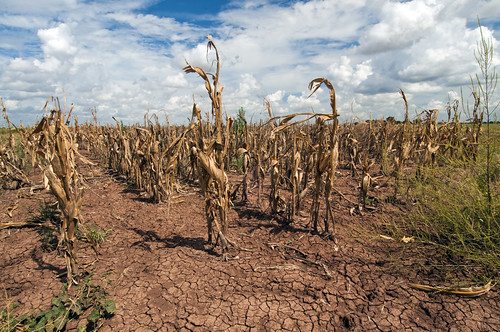
I am a research scientist, by nature, training, and now more than 30 years of experience. I hold degrees in Physics, Atmospheric Sciences, Meteorology, and have done research in many sub-specialties of the last two, including climate science. My curiosity about the natural world never slows down, and I am not intimidated by difficult problems. But the research I’ve been doing since 1999 has been the most challenging: how do we transform what we know about weather, weather variability, climate, and climate change into practical advice for farmers and ranchers? This is not just one problem in my mind, but three. Three huge gnarly problems, each close to intractable. But these new USDA Climate Hubs are an opportunity to make progress on all three. What follows are thumbnails of the three problems I have in mind, and then briefly how I see the Climate Hubs providing a handle on them.
First, there is the problem of the rapid evolution of climate science, and the communication of our results. This is a huge, ongoing research effort, spread across the globe, and the related considerations (“What should we do about it?”) have been radically politicized. There is so much being published, so much being developed, so many new centers and initiatives started, that no single person can stay up with all of it. For someone new to this arena, it is terribly confusing, filled with jargon, hard to tell one “product” from another, impossible to ferret out accuracy or representativeness - just a mess of epic proportions. I’ve talked to many people (including agricultural scientists) who searched for useful information related to climate, failed, and gave it up as wasted effort. There’s just too much out there.
Second, there is the problem of transforming climate science into knowledge within the agricultural sciences. Just because we are all scientists does not mean we understand each other easily - it takes a lot of work to communicate, effort that must be sustained over years, and frequently there is little motivation to even try. Worse, for many scientists, this kind of inter-disciplinary R&D is damaging to our careers. I can speak from experience when I say it has been difficult to publish my results, and for most Ph.D.’s the situation is still “publish or perish”. Very few organizations functionally support this kind of inter-disciplinary and cross-agency research, especially when federal funding is tight. So the essential cross-talk does not happen enough to make significant headway on the wide range of agricultural problems in the U.S. resulting from climate change.
Third, when we scientists do manage to get together and communicate, there is the problem of creating practical advice from our combined understanding. How do we generate guidance that covers the many different forms and kinds of agriculture, the different local environments and climate variations? For example, the droughts are coming more often in the Southern Great Plains, can be deeper, last longer – what can producers here do differently to stay profitable? Clearly, there is no simple answer that works for everyone. In this part of the world, mixed enterprises are common: multiple crops (grains and forages) and livestock. Factors related to variable climate have to be considered along with market realities, limited resources, conservation initiatives, loan options, other physical and financial constraints. So part of the answer is to work with specialists in adult science education, and with Extension agents and Natural Resources Conservation Service county field agents with related real-world experience. Unfortunately, all of these people are already too busy, over-loaded, working in agencies that have also had recent budget cuts. And we honestly need to do more directed research, to take ideas that worked in one county and test them elsewhere, or combine small successes in single enterprises into the more complex operations typical here. Not simple, not quick, not easy. Another aspect to this last problem is, well, political - the phrase “climate change” is a conversation stopper for many farmers and ranchers in the Southern Great Plains. Collectively, we need to make double-sure that our offerings of climate-savvy agronomic advice are immediately relevant and applicable to the problems that farmers, ranchers, foresters, are currently facing. We need to make obvious sense, so we can get past the politics.
So now back to the USDA Climate Hubs. Look at our plans when you can, and I think you’ll immediately see that the Climate Hubs intend to address all three of these problem areas. The first by creating a one-stop-shop opportunity for climate-savvy practical guidance related to agriculture and silviculture, while avoiding duplication of work being done by other agencies and groups. The second by fostering and rewarding the necessary inter-disciplinary research, across federal, state, university, non-profit, and private entities. The third by creating or revitalizing the link between climate-related applied research and in-the-field outreach…delivering a service that is currently close to non-existent for many who make their living off the land. Don’t get me wrong - there is a lot of advice out there, but it doesn’t take variable and changing climate into account. Not yet.
I think we have a chance to change that.
